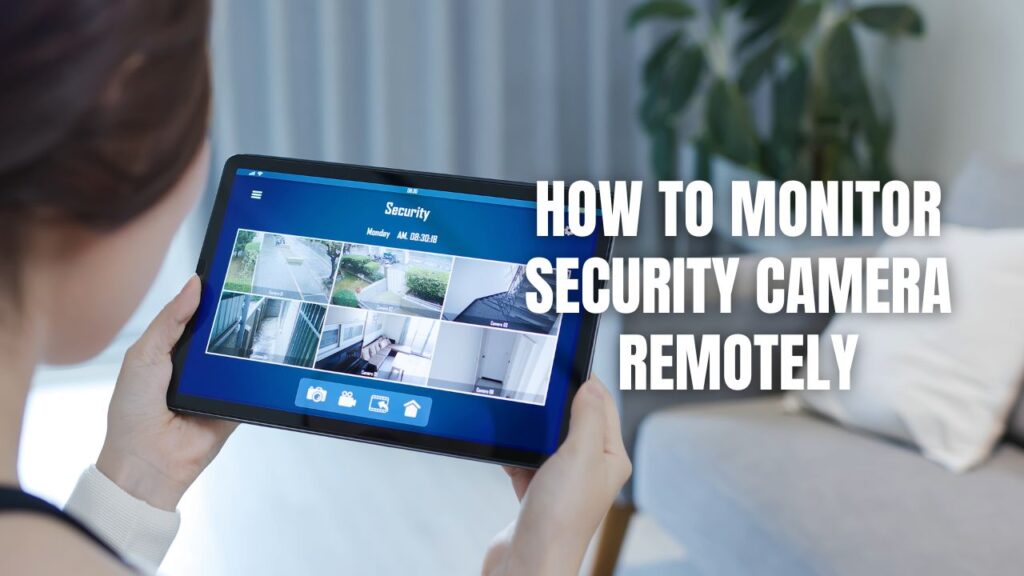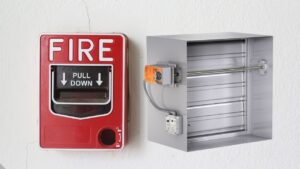In recent years, home security has become incredibly important to families across the country. As crime rates continue to fluctuate, more and more homeowners are taking proactive measures to protect their properties. One of the most effective ways to do this is by installing security cameras. With the right equipment, you can keep an eye on your home even when you’re halfway across the world!
Remote monitoring of security cameras is easier now than ever before. Advances in home Wi-Fi networks, mobile apps, and cloud storage services enable you to check feeds and receive alerts no matter where you are. While professional installation is recommended for most camera setups, DIY options make remote viewing simple and affordable.
In this guide, we’ll walk through everything you need to know to monitor security cameras remotely. We’ll cover:
- Critical factors when choosing home security cameras
- Professional installation vs. DIY options
- Necessary equipment for remote monitoring
- Accessing camera feeds on mobile devices
- Using cloud storage services
- Receiving motion alerts and customized notifications
- Maintaining privacy and internet security
- Future advancements on the horizon
Key Factors When Choosing Security Cameras
The first step is selecting the right security cameras for your home. Here are some key factors to consider:
Indoor vs. Outdoor
Outdoor cameras must withstand the elements, so look for weatherproofing and night vision capabilities. Indoor cameras can be more compact and inconspicuous.
Wired vs. Wireless
Wired cameras provide continuous power and connect to your home network via ethernet cables. Wireless cameras are powered by batteries or solar and transmit feeds wirelessly.
Video Resolution
Higher resolution captures more detail. 720p is adequate for most, while 1080p offers sharper image quality.
Field of View
A wider field of view covers more area, while a narrow view provides focused monitoring.
Night Vision
Infrared night vision allows clear footage in low light and at night. Important for cameras covering entryways or driveways.
Two-Way Audio
Models with built-in microphones and speakers allow voice communication through the camera. Helpful for warding off intruders.
Smart Features
Perks like facial recognition, motion tracking, and activity alerts provide next-level monitoring. Require more powerful (and expensive) systems.
Storage Options
recordings can be saved locally on SD cards or via cloud services. Local storage gives you full ownership of footage, while cloud plans provide offsite access.
Once you select cameras that match your needs and budget, it’s time to tackle installation.

Professional Installation vs. DIY Options
Professional installation takes the guesswork out of setting up a security camera system. Technicians handle the entire process, from assessing your property’s layout to configuring the equipment for seamless functionality. The benefits of pro installation include:
- Optimized camera placement and settings
- Complete setup and activation
- Integration with your WiFi network
- Testing connectivity and remote access
- Technical support for ongoing maintenance
However, professional services come at a steep cost. Installation fees can run hundreds of dollars or more depending on the system.
For many homeowners, DIY installation offers an affordable alternative. Today’s wireless systems are designed for easy self-setup. With a little technical know-how, you can mount cameras and connect them to your home network on your own. Here are some tips for smooth DIY installation:
- Carefully follow included setup guides and use manufacturer tech support if needed.
- Consider ease of access when mounting cameras to walls, ceilings, or exteriors.
- Use a mobile app to view camera feeds as you adjust positioning.
- Connect wireless cameras to power outlets centrally located in their vicinity.
- Register cameras to your WiFi router and confirm connectivity.
- Test remote access by viewing feeds from your smartphone away from home.
We recommend DIY installation for tech-savvy homeowners with relatively simple, low-camera count systems. But for more complex setups, letting the professionals handle it can give you greater peace of mind.
Necessary Equipment for Remote Monitoring
Once your cameras are mounted in optimal spots, you’ll need additional equipment for reliable remote monitoring. Here are the essentials:
Reliable Home WiFi Network
A high-speed home internet connection is crucial for streaming feeds smoothly and avoiding playback issues like buffering or video lag. If your WiFi is spotty, consider upgrading your wireless router or switching internet providers.
Cloud Storage Service
Recordings can eat up hard drive space quickly. A cloud storage subscription allows continuous capture without capacity limits. Popular options like Nest Aware or Arlo Smart offer plans with varying storage amounts.
Smartphone or Tablet
A mobile device is your portal to tap into your cameras on-the-go. Make sure to download your camera manufacturer’s app to access live streams and recordings.
Mobile Hotspot (Optional)
If your home internet goes down, a mobile hotspot lets you connect your cameras to 3G/4G LTE networks for monitoring access anywhere.
Remote Access Hub (For Advanced Systems)
Central hubs like Canary Flex allow multi-camera setups to be accessed remotely through one centralized device. Worth the investment for homes with 4+ cameras.
With the right foundation of high-speed internet, ample cloud storage, and mobile apps, you’re ready to monitor from afar!
Accessing Camera Feeds on Mobile Devices
Perhaps the most convenient perk of a remote security camera system is the ability to view live footage and recordings straight from your smartphone or tablet, any time.
To set up mobile access:
- Download your security camera’s app, create an account, and sign in.
- Connect your cameras to the app and your home WiFi network.
- Adjust app permissions so it can run in the background and send you notifications.
- Ensure cameras are powered on so they remain accessible.
Now you can simply launch the app and instantly tap into feeds over local WiFi or mobile data. Features like zoom, real-time playback controls, microphone talkback and more are at your fingertips.
If leaving home, switch on your phone’s mobile hotspot and connect cameras to it so you maintain access on-the-go without relying on your home internet.
Using Cloud Storage Services
Recording continuously would quickly max out local storage like SD cards. Cloud services provide unlimited, offsite capacity for continuous capture so you never miss a moment.
Popular options like Nest Aware and Arlo Smart integrate directly with their respective camera systems. Choose a package based on:
Storage amount – How many days of recordings you want stored. Ranges from 30 days up to 60 days for premium plans.
Number of Cameras – Number of devices you can connect, from 1 up to 10+ for larger homes.
Smart Features – Advanced tools like facial recognition or AI-based alerts. Require more expensive packages.
Price – Entry-level plans start around $5-10/month. Prices go up with more features and cameras. Can save with 1-2 year pre-paid plans vs. monthly billing.
With cloud storage powering your cameras, you don’t have to worry about overflowing capacity or losing important footage. Play back events right from your mobile app.
Receiving Alerts and Customized Notifications
Remote monitoring lets you do more than just watch live feeds. You can configure your cameras to proactively notify you of any activity when you’re away.
Motion Alerts notify you anytime the cameras detect movement. Sensitivity is adjustable to reduce false alarms.
Activity Zones let you draw specific areas in the camera’s field of view that will trigger alerts when motion occurs there. Tailor them to key areas like entryways, gates, etc.
Smart Alerts use AI to distinguish between people, vehicles, animals, and other objects. Get notifications only for events that matter, like an unknown person on your porch.
Two-Way Talk activates your camera’s microphone and speaker for voice warnings to unwanted guests.
Customize monitoring by setting schedules, enabling alerts only during certain hours or when you’re out of town.
Maintaining Privacy and Internet Security
While home security cameras provide invaluable awareness, it’s crucial to align monitoring practices with ethical privacy standards. Here are tips for maintaining safety without intruding on others’ reasonable expectations of privacy:
- Only record your own property, avoiding pointing cameras at or into neighbors’ homes.
- Notify visitors they are being recorded with clearly posted signs around monitored areas.
- Turn off recording when entertaining guests who have not consented to being filmed in your private residence.
- Use smart motion alerts instead of continuous capture so recordings are only captured during potential security events.
- Enable encryption and use strong passwords to prevent hacking of camera feeds.
- Educate children on the proper and improper uses of security footage to foster responsibility.
With thoughtful precautions, cameras can prevent crime and give you assurance without crossing ethical lines.
The Future of Remote Camera Monitoring
Home security technology will only continue advancing, opening new possibilities for monitoring your property from anywhere. Exciting innovations on the horizon include:
- Improved video analytics – Onboard AI will get even smarter at recognizing faces, objects, behaviors and suspicious activity to enable more discerning, customized alert triggers.
- Enhanced mobile access – As mobile networks upgrade to 5G and WiFi 6, live streams and video playback will become more stable and responsive on phones/tablets letting you monitor seamlessly from afar.
- Expanded integration – Wider smart home integration will allow security cameras to arm/disarm connected smart locks, lighting, alarms and more based on customizable monitoring rules.
- Drones – Security drones equipped with cameras can autonomously patrol and monitor large outdoor areas and send live feeds straight to your device.
- AR/VR monitoring – Emerging augmented and virtual reality tech will immerse you into your home remotely with interactive, 3D security camera feeds.
- Next-gen image sensors – New camera image sensors with proprietary video formats provide radically improved video clarity in any lighting.
- Mesh networks – Mesh-enabled cameras that form their own decentralized wireless network will eliminate WiFi dead zones and range limitations for whole-home coverage.
- Automated response – Cameras may soon be able to go beyond notifications and alerts to take automated countermeasures like activating smart sprinklers or alarms to deter trespassers.
- 8K video – While still a ways off for mainstream use, 8K cameras will one day deliver staggeringly detailed security footage beyond today’s 1080p/4K standards.
While innovations like these indicate exciting times ahead, today’s cameras already deliver intelligent, robust remote monitoring to protect what’s most important. Following our tips above, you can install an affordable system to watch over home and family from anywhere. With proper configuration for optimal coverage, connectivity and notifications, you can enjoy next-level peace of mind no matter where life takes you.
For security camera installations around North and Central Georgia, contact Callaway Security today!








